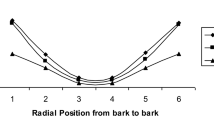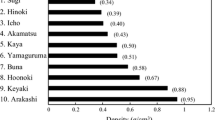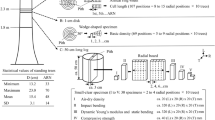Abstract
The effect of annual rings’ orientation on bending strength was examined on subfossil elm wood. Elm is extremely rarely found as subfossil wood, and during the last 50–60 years it has almost disappeared from natural forest stands of south-eastern Europe, due to the Elm Dutch disease. The samples were cut from approximately 670 years old subfossil elm trunk retrieved from the bed of the river Sava in the area between the villages Grebnice and Domaljevac in north Bosnia. The wood was identified to the genus level based on optical microscopy analysis of three wood sections—transverse, tangential and radial. Bending strength was determined by the three-point bending test. The load was applied to the longitudinal–tangential surface (LT) and to the longitudinal–radial surface (LR). The bending strength values of subfossil elm do not differ from the values of recent elm, despite the 700-year resting in anoxic river conditions. Bending strength in LT direction was slightly higher than bending strength in LR direction. The coefficient of variation and the standard deviation of the arithmetical mean were higher for LT direction. It was found that the measured bending strength for both directions follows Weibull distribution. Coefficient of determination of Weibull functions was close to 1 for both directions. The Weibull shape parameter was higher for LR direction.
Similar content being viewed by others
Introduction
This study used samples obtained from approximately 670 years old subfossil elm trunk. The samples were made of elm tree retrieved from the bed of the river Sava in the year 2014, in the area between the villages Grebnice and Domaljevac in Bosnia and Herzegovina (Fig. 1). Fossil wood is the term used for wood which was located for a long time (from a few hundred years up to several tens of thousands) in the ground, under the influence of flowing water in the process of humification. Running water that surrounds the wood is responsible for unfavourable condition for the growth of microorganisms and fungi that destroy wood, in addition to the deposition of minerals from the river. All those ensure wood durability and preservation [1]. Subfossil wood shows high durability due to changes in the chemical structure, physical and mechanical properties [2–4] and its value is also reflected in great aesthetic qualities, often black colour and acoustics. These are all reasons why fossil wood is used for making valuable furniture, sculptures, jewellery and high-quality products for everyday use.
a Location of Bosnia and Herzegovina with neighbouring countries and the area where our samples were taken from (red rectangle), b closer look of river Sava at the investigation area (https://www.google.hr/maps) (colour figure online)
Previous investigations of subfossil elm wood in Bosnia and Croatia are not known to us. The research was only done on subfossil oak samples [1, 5, 6], so this paper will detail the first data about the mechanical properties of the elm fossil wood. Elm has generally been little explored since, in the 1920s, there began mass drying of elm trees in Europe due to the Dutch elm disease (Ophiostoma novo-ulmi Brasier). The greatest decline of elm in the forests of Posavina (area along the Sava river) occurred between 1950 and 1955, and this is why one can rarely find nowadays an adult elm tree capable of reproduction [7, 8]. To protect the species (Ulmus minor s. l.) and improve the knowledge about it, researchers did an investigation on variability of elm leaf morphology from trees from continental Croatia [9, 10].
Wood is a natural material and has a very heterogeneous and orthotropic structure. That is why its mechanical properties differ significantly in the direction of longitudinal, radial and tangential axes of the wood. The direction of force in relation to annual rings also affects the mechanical properties in the longitudinal direction of the wood [11–15]. This study was aimed at examining the effect of a ring angle on the bending strength parallel to the grain of the wood. The bending strength is one of the most commonly determined mechanical wood properties. We wanted to compare the literature data about that property to the data obtained on subfossil elm. This comparison has shown whether specific aquatic conditions over centuries have changed the value of the elm wood bending strength.
Materials and methods
Samples
All samples for investigation were taken from the outer part of the heartwood of subfossil elm trunk. The elm tree was retrieved from riverbed in the year 2014. Radiocarbon analysis (conducted in Ruđer Bošković Institute, Zagreb, Croatia), with 95% confidence placed this elm trunk in the period between 1263 and 1400 cal AD.
Bending test
The bending strength was determined on 6 × 6 × 82 mm samples by a three-point bending test using the Messphysik BETA 50-5 screw-drive testing machine. The distance between the centres of the support rollers was set to 74 mm. The diameter of the loading and support rollers was 10 mm. All tests were conducted at room temperature (22 °C) and humidity was 48%. The constant cross-head speed was 2.8 mm/min. The deflection was measured with video extensometer (ME 46, Messphysik) and for the measuring of the load GTM 6.3 kN, the load cell was used. All specimens were loaded until their fracture.
Figure 2 shows sampling method for the wood specimens for bending test on the cross section of the subfossil elm trunk. An average annual ring width in this area was 1.05 mm. Two sets of samples were used, each one contained 32 samples. The first set was tested with loads applied to the longitudinal–tangential surface (LT) and the second with loads applied to the longitudinal–radial surface (LR). The width and the thickness of the test samples were measured before testing and the load–deflection relations were registered during each test. After the bending test the content of moisture and density of wood was determined according to ISO 13061 [16]. The moisture content (calculated as the loss in mass by drying of a sample to the constant mass at 103 ± 2 °C) was 7.5%. The density for this moisture content was 0.5324 g/cm3.
Bending strength (MPa) of each sample was calculated from the obtained data from the formula: σ = \(\frac{{ 3 { }F_{ \hbox{max} } l_{ 1} }}{{ 2 { }bt^{2} }},\) where
F max is the maximum load (N)
l 1 is the distace between the centres of the supports (mm)
b is the width of the test sample (mm)
t is the thickness of the test sample (mm)
Statistics
The variability of bending strength was described with the well-established Weibull distribution. This statistical method is widely utilised to assess the reliability of various mechanical properties of heterogeneous materials [17].
Analysis of wood microstructure
The wood we used for research was identified to the genus level based on analysis of three wood sections (transverse, tangential and radial). The samples were cut on microtome and examined under the OLYMPUS BX 51-P light microscope.
Results and discussion
Elm species
The wood sections (transverse, tangential and radial) examined under a light microscope are shown in the Fig. 3. The species of the genus Ulmus cannot be distinguished with certainty only with the microscopic analysis of the wood anatomy [18], so we can only assume which exact species of elm we researched. In Croatia, according to the Flora Croatica Database [19], there are 6 members of the genus Ulmus. The species Ulmus glabra, U. procera and U. pinnato-ramosa due to geographical and habitat reasons almost certainly did not grow in the area of origin of our sample [20–22]. The species U. laevis and U. minor (U. canescens, which some authors consider subspecies of U. minor) regularly grow on alluvial, flooded fields and along the rivers [21], so we are almost sure that our samples are made of one of these two species.
Wood microstructure
Transverse section shows that this wood is ring-porous. Early wood has 1–3 rows of pores and latewood pores are grouped in more or less long, tangential to slightly oblique, 2–4 seriate bands together with vascular tracheids and parenchyma. Tangential section shows 4–5 seriate rays. Height of rays is from 30 to approximately 50 cells. In radial section rays are generally homogenous. Spiral thickenings are conspicuous in vessels.
Bending strength
The obtained results for the measured bending strength for both directions (LT and LR) are shown in Table 1 and samples after testing in Fig. 4. The table details minimum, maximum, mean, standard deviation and coefficient of variation, as well as parameters of 2-parameter Weibull function and determination coefficient. Bending strength values for both directions, 89.16 for LT and 88.01 for LR, are within the limits for recent elm wood, found in the literature [23]. The results were compared only with literature data because it is very difficult to get samples of recent fresh elm for the already mentioned reasons. The reason for this is the extinction of elm from natural wood stands for over half a century in the area of Posavina due to Elm Dutch disease. The value of bending strength in the LT direction is slightly higher (1.3%) then the one in the LR direction. Such a ratio of the bending strength value in LT and LR direction coincides with the research of Douglas fir [24]. This behaviour has also been observed regarding other mechanical properties, such as are Young’s modulus for compression, tested on Norway spruce [11]. However, it is known that the ratio can also be different. In some species there is no difference in 0° and 90° orientation properties and some have a higher value of the bending strength for LR [13]. The difference in this and other mechanical properties lies in the fact that the wood is an anisotropic material. The porosity and layering of wood, and in particular the orientation of ray cells in relation to the annual rings, affect the values of mechanical properties [12].
The Weibull shape parameters characterise the variation of bending strength. The higher value of shape parameter in LR direction indicates smaller variability of bending strength. Coefficient of determination for both directions was close to 1. The higher coefficient of determination for LT direction gives the greater goodness of fit.
The variations in bending strength are shown in Fig. 5 with the probability density function, the cumulative distribution function for the normalised bending strength and Weibull plot (linear-regression method for determination of Weibull parameters).
Conclusion
Microscopic analysis of the anatomy of the studied wood, observed in three sections (transversal, tangential and radial) showed that our sample originates from genus Ulmus (elm) and radiocarbon dating placed this trunk with 95% confidence in the period between 1263 and 1400 cal AD. The subfossil elm wood is extremely rare to find and due to the Elm Dutch disease, it is almost impossible to find elm in natural woods of South East Europe in the last 50-odd years.
The bending strength of subfossil elm trunk was determined by three-point bending test. Load was applied to the longitudinal–tangential surface (LT) as well as the longitudinal–radial surface (LR). The measured values of bending strength in LT direction were slightly higher (1.3%) than bending strength in LR direction. The coefficient of variation and the standard deviation of the arithmetical mean were higher for LT direction.
It was found that the measured bending strength for both directions follows Weibull distribution. The Weibull shape parameter was higher for LR direction. The determination coefficients (goodness of fit) were close to 1.
The obtained results for bending strength are within the range of values for recent elm wood.
This research has shown that the resting of elm in specific river conditions for many centuries has not significantly changed the microstructure and bending strength of the wood.
References
Sinković T, Govorčin S, Dubravac T, Roth V, Sedlar T (2009) Comparison some physical and mechanical properties of abonos and recent oak (Quercus robur L.) (in Croatian). Šumarski list 11–12:605–611
Fengel D (1991) Aging and fossilization of wood and its components. Sci Technol 25:153–177
Fengel F, Wegener G (1984) Aging and fossilization. In: Fengel D, Wegner G (eds) Wood, chemistry, ultrastructure, reactions. Walter de Gruyter, Berlin, pp 407–413
Christiernin M, Notley SM, Zhang L, Nilsson T, Henriksson G (2009) Comparison between 10,000-year old and contemporary spruce lignin. Wood Sci Technol 43:23–41
Govorčin S, Sinković T (1994) Some physical and mechanical properties of Bednja Abonos. In: The 2nd International Symposium „Wood Structure and Properties 94“, Zvolen, pp 143–150
Govorčin S, Sinković T (1995) Some physical and mechanical properties of Bednja abonos (black oak buried in the ground) (in Croatian). Drvna Industrija 46(1):9–14
Jureša B (1976) Drying of oak, ash and elm in the period 1950-1974 in the area of Vinkovci (in Croatian). Šumarski List 1–2:61–66
Wilkinson G (1973) Trees in the wild: And other trees and shrubs. Stephen Hope Books, London, pp 79–84
Zebec M, Idžojtić M, Poljak I, Mihaldinec I (2010) The variability of field lem (Ulmus minor Mill. sensu lato) in Croatian Drava river valley according to the leaf morphology. Šumarski List 11–12:569–580
Zebec M, Idžojtić M, Poljak I (2014) Morphological variability of the field elm (Ulmus minor Mill. sensu latissimo) in continental Croatia. Šumarski List 11–12:563–572
Miksic A, Myntti M, Koivisto J, Salminen L, Alava M (2013) Effect of fatigue and annual rings’ orientation on mechanical properties of wood under cross-grain uniaxial compression. Wood Sci Technol 47:1117–1133
Nairn JA (2007) A numerical study of the transverse modulus of wood as a function of grain orientation and properties. Holzforschung 61(4):406–413
Green DW, Winandy JE, Kretschmann DE (1999) Mechanical properties of wood forest products laboratory. In: Wood handbook: wood as an engineering material. USDA Forest Service, Forest Products Laboratory, Madison, WI, General technical report, pp 4.1–4.45
Riyanto DS, Gupta R (1996) Effect of ring angle on shear strength parallel to grain of wood. For Prod J 46(7/8):87–92
Ochtani T, Yakou T, Kitayama S (2002) Effect of annual rings on abrasive wear property of wood. J Wood Sci 48:264–269
ISO 13061 (2014) Physical and mechanical properties of wood–test methods for small clear wood specimens. International Organization for Standardization, Geneva
Shih-Hao L (2014) Estimation and comparison of Weibull parameters for reliability assessments of Douglas-fir wood. IJBAS-IJENS 14(2):18–21
Schweingruber FH (2011) Anatomy of European woods (in German and English). Verlag Kessel, Remagen-Oberwinter, pp 726–727
Nikolić T (ed) (2016) Flora Croatica Database. http://hirc.botanic.hr/fcd/. Accesed 25 June 2016
Trinajstić I (2001) Turkestanean ulm–Ulmus pinnato-ramosa Dieck ex Koehne in the dendroflora of Croatia. Šumarski List 9–10:533–537
Clapham AR (1975) The Oxford book of trees. Oxford University, Oxford
Boom BK, Kleijn H (1966) Großes Fotobuch der Bäume (in German). Bayerischer Landwirtschaftsverlag, München
Trajković J, Despot R (1997) Elm wood (in Croatian). Drvna Industrija 48(2):116
Grotta A, Leichti RJ, Gartner BL, Johnson GR (2005) Effect of growth ring orientation and placement of earlywood and latewood on MOE and MOR of very small clear Douglas fir beams. Wood Fiber Sci 37(2):207–212
Acknowledgements
We would like to thank a lot to Marijan Lucić who provided material for this project. Many thanks also to Prof. Mario Essert for helping us with statistics and Peter Doig, BSc Hons. for linguistic corrections of our article. Funding was provided by Horizon 2020 (Grant No. 692249)
Author information
Authors and Affiliations
Corresponding author
About this article
Cite this article
Rede, V., Essert, S. & Kodvanj, J. Annual ring orientation effect on bending strength of subfossil elm wood. J Wood Sci 63, 31–36 (2017). https://doi.org/10.1007/s10086-016-1596-x
Received:
Accepted:
Published:
Issue Date:
DOI: https://doi.org/10.1007/s10086-016-1596-x









